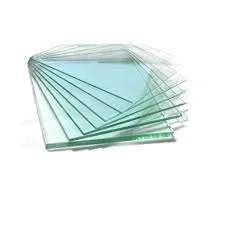The float glass manufacturing process has revolutionized the production of flat glass, offering unparalleled quality and efficiency. This innovative method, which has become the backbone of the glass industry, combines advanced technology with precision engineering to produce glass that meets the highest standards of clarity and uniformity.

The journey begins with raw materials, primarily silica sand, soda ash, and limestone. These components are carefully measured and mixed to create a batch that is fed into a furnace. The furnace, operating at temperatures exceeding 1,700 degrees Celsius, transforms this mixture into molten glass. This stage is crucial; the precise control of temperature ensures the removal of impurities, which is essential for producing high-quality glass.
Once the mixture reaches the desired consistency, the molten glass is transported to the float bath.
Here lies the ingenuity of the float glass process. The molten glass is carefully poured onto a bath of molten tin. Glass, being less dense, floats on the surface, naturally spreading out to form a flat sheet. The smoothness of the molten tin surface and the force of gravity work in tandem to yield a perfectly uniform thickness without the need for mechanical rollers, which can compromise the surface.

As the continuous ribbon of glass moves along the float bath, the temperature gradually decreases, allowing the glass to solidify while maintaining its flat form. This stage is meticulously monitored to ensure any thermal stresses are minimized, preventing imperfections that could affect the structural integrity or clarity of the final product.
Next, the cooled glass ribbon enters the annealing lehr, an extended kiln that further stabilizes the glass. Here, it undergoes controlled cooling, a process that relieves internal stresses induced during formation. This careful annealing ensures that the glass is not only flat and smooth but also endowed with optimal strength and durability.
float glass manufacturing process
The final stage involves cutting and quality inspection. State-of-the-art sensors and human expertise are deployed to detect any blemishes or inconsistencies. Each piece of glass is subjected to rigorous quality checks, ensuring compliance with industry standards before it reaches the market.
The float glass manufacturing process is not only a marvel of industrial engineering but a testament to the advances in material science. Its impact extends beyond simple flat glass production. By innovatively adapting this process, specialized products like coated glass, tinted glass, and even smart glass have been developed, each catering to specific industry needs ranging from energy efficiency to architectural aesthetics.
Given the importance of such innovations, stakeholders in the construction and automotive industries often consult with experts in float glass manufacturing to guide product development and application. These professionals, through years of experience, offer invaluable insights into optimizing glass usage, ensuring enhanced performance and sustainability in projects.
In understanding the float glass manufacturing process, companies gain a competitive edge, allowing them to innovate and adapt in an ever-evolving market landscape. Trust in this process is paramount, as the integrity of the final product impacts safety, performance, and aesthetics across various applications, from towering skyscrapers to cutting-edge vehicles.
 Afrikaans
Afrikaans  Albanian
Albanian  Amharic
Amharic  Arabic
Arabic  Armenian
Armenian  Azerbaijani
Azerbaijani  Basque
Basque  Belarusian
Belarusian  Bengali
Bengali  Bosnian
Bosnian  Bulgarian
Bulgarian  Catalan
Catalan  Cebuano
Cebuano  Corsican
Corsican  Croatian
Croatian  Czech
Czech  Danish
Danish  Dutch
Dutch  English
English  Esperanto
Esperanto  Estonian
Estonian  Finnish
Finnish  French
French  Frisian
Frisian  Galician
Galician  Georgian
Georgian  German
German  Greek
Greek  Gujarati
Gujarati  Haitian Creole
Haitian Creole  hausa
hausa  hawaiian
hawaiian  Hebrew
Hebrew  Hindi
Hindi  Miao
Miao  Hungarian
Hungarian  Icelandic
Icelandic  igbo
igbo  Indonesian
Indonesian  irish
irish  Italian
Italian  Japanese
Japanese  Javanese
Javanese  Kannada
Kannada  kazakh
kazakh  Khmer
Khmer  Rwandese
Rwandese  Korean
Korean  Kurdish
Kurdish  Kyrgyz
Kyrgyz  Lao
Lao  Latin
Latin  Latvian
Latvian  Lithuanian
Lithuanian  Luxembourgish
Luxembourgish  Macedonian
Macedonian  Malgashi
Malgashi  Malay
Malay  Malayalam
Malayalam  Maltese
Maltese  Maori
Maori  Marathi
Marathi  Mongolian
Mongolian  Myanmar
Myanmar  Nepali
Nepali  Norwegian
Norwegian  Norwegian
Norwegian  Occitan
Occitan  Pashto
Pashto  Persian
Persian  Polish
Polish  Portuguese
Portuguese  Punjabi
Punjabi  Romanian
Romanian  Russian
Russian  Samoan
Samoan  Scottish Gaelic
Scottish Gaelic  Serbian
Serbian  Sesotho
Sesotho  Shona
Shona  Sindhi
Sindhi  Sinhala
Sinhala  Slovak
Slovak  Slovenian
Slovenian  Somali
Somali  Spanish
Spanish  Sundanese
Sundanese  Swahili
Swahili  Swedish
Swedish  Tagalog
Tagalog  Tajik
Tajik  Tamil
Tamil  Tatar
Tatar  Telugu
Telugu  Thai
Thai  Turkish
Turkish  Turkmen
Turkmen  Ukrainian
Ukrainian  Urdu
Urdu  Uighur
Uighur  Uzbek
Uzbek  Vietnamese
Vietnamese  Welsh
Welsh  Bantu
Bantu  Yiddish
Yiddish  Yoruba
Yoruba  Zulu
Zulu 


